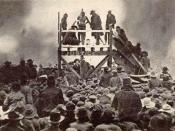Ida B. Wells' Campaign The anti-lynching campaign of Ida B. Wells took place in the post-Reconstruction era. By the end of the Civil War, slavery was abolished but there was a problem. No one knew what to do with all the ex-slaves. They didn't know how to put them into the existing society. During this period, the government was starting to take control of social and political issues. They were taking it upon itself to make the regulations. Things were coming back to the way they were before. Although African Americans were free and had legal rights, the government was putting restrictions on them as if they were slaves again but without actually referring to them as slaves.
During the post-Reconstruction era, lynching was thought to be a rational punishment since the law was out of order there was no other alternative. Most whites believed that blacks were brutes and that they should be destroyed.
During slavery, lynching of slaves hardly existed because if they lynched their slaves they would be destroying their own property and it would be worthless. But, now that the slaves were free, they were no longer property and were worthless so why not get rid of them? After much political and emotional interest in lynching, Ida B. Wells launched her anti-lynching campaign in 1892 in which 241 people were lynched. Through her hard work and determination she made a great mark in history. With the distribution of her pamphlets she was able to help people realize that the information that was out there was not necessarily true. She showed people the truth of what was going on and decided that it had to be stopped.
Many might say the her efforts were a failure but in the statistics she made a difference.

![English: , Chicago, Illinois]]](https://s.writework.com/uploads/11/116744/english-chicago-illinois-thumb.jpg)
